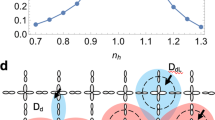Abstract
Since the discovery of the high temperature superconductivity in cuprates, it has been believed by many researchers that an electronic mechanism could be responsible for the high values of Tc [1], A distinctive feature of high-Tc copper oxide superconductors is strong antiferromagnetic (AFM) exchange interaction (see, for example, [2]). The exchange binding energy of two holes with spin 1/2 in copper Cu(3d9) and oxygen O(2p6)ions comprises a value of order 1 eV, and the indirect (through oxygen ions) AFM exchange energy of holes in copper ions is of order 0.13 eV. If cuprates had a three- dimensional network of bonds for copper spins, the AFM Néel temperature in these materials could reach a record value 1500 K. However, because of the layered structure of cuprates the Néel temperature turns out to be much lower, TN ≃ 300 – 500 K, though still very high.
Access this chapter
Tax calculation will be finalised at checkout
Purchases are for personal use only
Preview
Unable to display preview. Download preview PDF.
Similar content being viewed by others
References
For a review see Scalapino, D.J. (1995) The case for dx2_y2 pairing in the cuprate superconductors, Phys. Reports 250, 329–365.
Plakida, N.M. (1995) High-Temperature Superconductivity Springer, Heidelberg.
Anderson, P.W. (1987) The resonating valence bond state in La2CuO4 and superconductivity, Science 235, 1196; Anderson, P.W. (1997) The theory of superconductivity in the high-Tc cuprates Princeton University Press, Princeton, New Jersey.
Izyumov, Yu. A.(1999) Spin-fluctuation high-Tc superconductivity and the order parameter symmetry, Usp. Fiz. Nauk 169, 225–254.
Plakida, N.M., Yushankhai, V.Yu., and Stasyuk, I.V. (1989) On the role of kinematical and exchange interactions in superconducting pairing of electrons in the Hubbard model, Physica C 160, 80–88; Yushankhai, V.Yu., Plakida, N.M., and Kalinay, P. (1991) Superconducting pairing in the mean-field approximation for the t — J model: Numerical analysis. Physica G, 174, 401-409.
Izyumov, Yu.A. and Letfulov, B.M. (1992) Superconductivity in the Hubbard model with strong Coulomb repulsion, Intern. J. Modern Phys. B 6, 321–357.
Plakida, N.M. and Oudovenko, V.S. (1999) Electron spectrum and superconductivity in the t-J model at moderate doping, Phys. Rev. B 59, 11949–11961.
Plakida, N.M., Hayn, R., and Richard, J.-L. (1995) Two-band singlet-hole model for the copper-oxide plane, Phys. Rev. B 51, 16599–16607.
Feiner, L.F., Jefferson, J.H., and Raimondi, R. (1996) Effective single-band models for high-Tc cuprates. I. Coulomb interactions, Phys. Rev. B 53, 8751–8773.
Emery, V.J. (1987) Theory of high-Tc in oxides, Phys. Rev. Lett. 58, 2794–2797; Varma, CM., Schmitt-Rink, S., and Abrahams, E.,(1987) Charge transfer excitations and superconductivity in ionic metals, Solid State Commun. 62, 681-685.
Plakida, N.M., Anton, L., Adam, S., Adam, Gh., (2000) Exchange and spin-fluctuation superconducting pairing in the Hubbard model in the strong correlation limit, Preprint JINR, E-17-2001-59, Dubna; cond-mat/0104234.
Plakida, N.M. (2001) Antiferromagnetic exchange mechanism of superconductivity in cuprates, JETP Letters 74, 36–40.
Zubarev, D.N. (1960)Double-time Green’s functions in statistical physics, Sov. Phys. Usp. 3, 320–365.
Beenen, J. and Edwards, D.M. (1995) Superconductivity in the two-dimensional Hubbard model, Phys. Rev. B 52, 13636–13651.
Avella, A., Mancini, F., Villani, D., and Matsumoto H. (1997) The superconducting gap in the two-dimensional Hubbard model, Physica C 282-287, 1757–1758; Di Matteo, T., Mancini, F., Matsumoto, H., and Oudovenko, V.S. (1997) Singlet pairing in the 2D Hubbard model, Physica B 230-232, 915-917.
Stanescu, T.D., Martin, I., and Phillips, Ph. (2000) dx2 y2 pairing of composite excitations in the two-dimensional Hubbard model, Phys. Rev. B 62, 4300–4308
Lokshin, K.A., Pavlov, D.A., Putilin, S.N., et al (2001) Enhancement of Tc in HgBa2Ca2Cu3O8+ð Phys. Rev. B 63, 064511.
Zhao, G.-M., Singh, K.K., and Morris, D.E.(1994) Oxygen isotope effects on Néel temperature in various antiferromagnetic cuprates, Phys. Rev. B 50, 4112–4117.
Anderson, P.W. (1997) A re-examination of concepts in magnetic metals: the ‘nearly antiferromagnetic Fermi liquid’, Adv. in Physics 46, 3–11.
Author information
Authors and Affiliations
Editor information
Editors and Affiliations
Rights and permissions
Copyright information
© 2002 Springer Science+Business Media Dordrecht
About this chapter
Cite this chapter
Plakida, N.M., Anton, L., Adam, S., Adam, G. (2002). Exchange and Spin-Fluctuation Pairing in the Two-Band Hubbard Model. In: Annett, J.F., Kruchinin, S. (eds) New Trends in Superconductivity. NATO Science Series, vol 67. Springer, Dordrecht. https://doi.org/10.1007/978-94-010-0544-9_3
Download citation
DOI: https://doi.org/10.1007/978-94-010-0544-9_3
Publisher Name: Springer, Dordrecht
Print ISBN: 978-1-4020-0705-7
Online ISBN: 978-94-010-0544-9
eBook Packages: Springer Book Archive




